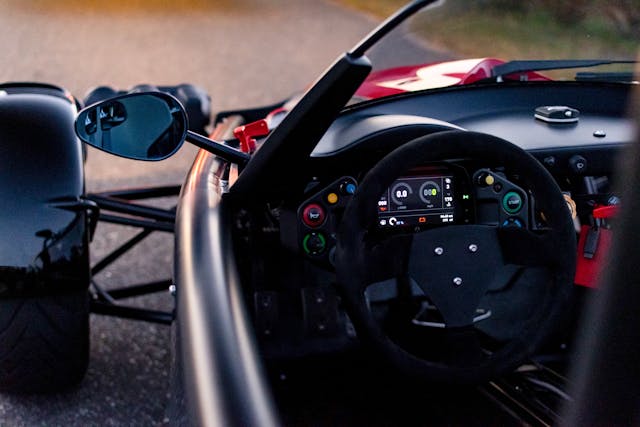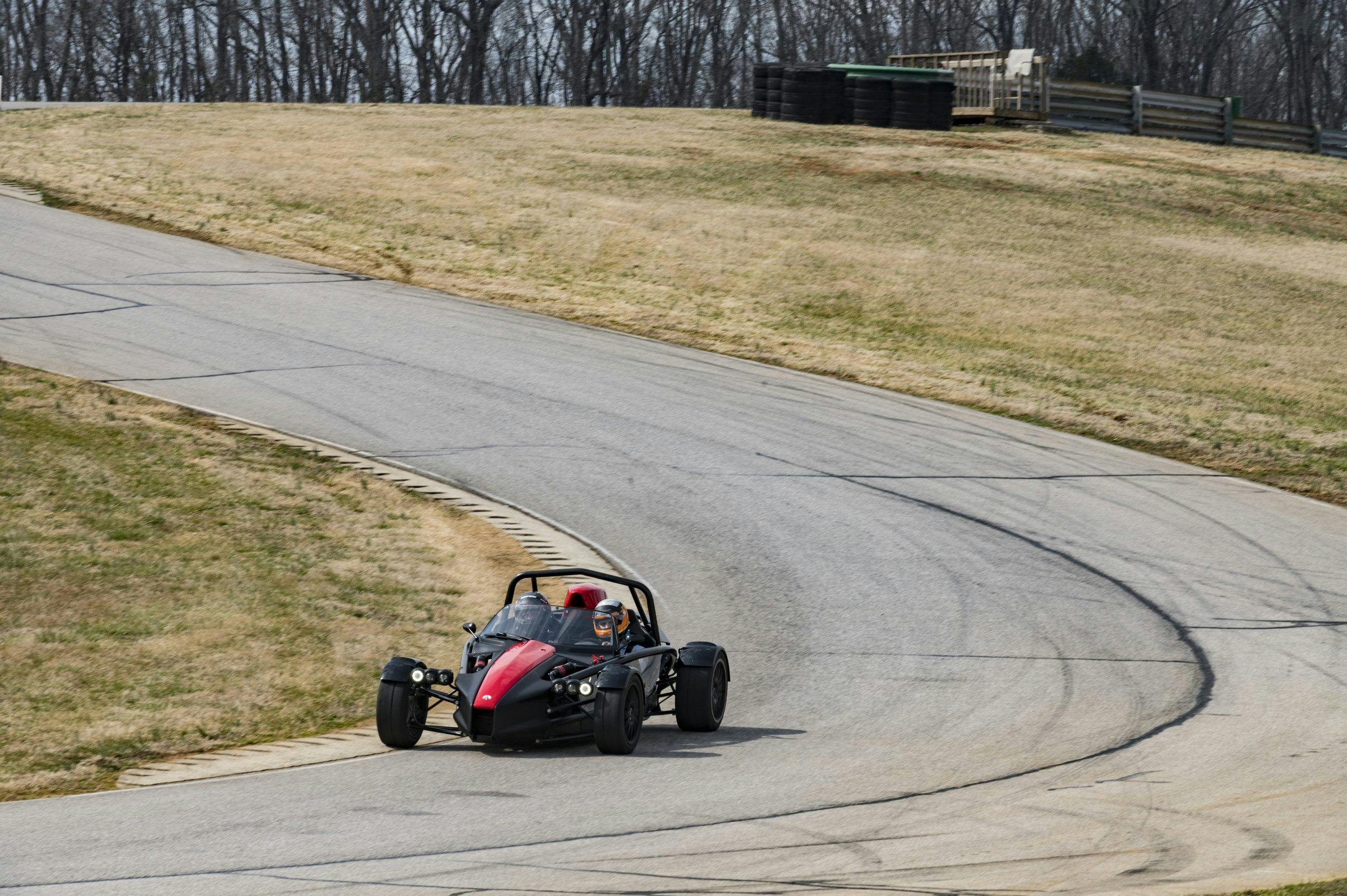Smithology: You wouldn’t think it’s a toothbrush

Fifteen years ago, I had no idea what an Ariel Atom felt like. Then I tested one on a back road in Oregon and recalled the old saw: Most cars drive about like they look. Every Atom ever sold looks crazy as a shoe full of bees.
Two weeks ago, I strapped into a new Atom yet again. In the paddock of Virginia International Raceway, at a media event put on by the car’s maker and designed to reacquaint journalists with the funky little ghost in the machine.
What’s the line from the last Mad Max movie? The film where Charlize Theron drives a Tatra truck while occasionally firing a very large gun, and the whole point seems to be that sanity is both conditional and highly overrated?
What a lovely day.
Rare bird, this. Ariel is a British company. Its North American arm currently builds around 70 Atoms per year, to order, in a small factory near Danville, Virginia. Ariel representatives admit that most Atoms are rarely driven. This makes little sense if you see an Atom as transport and very much sense if you simply view it as an experience simultaneously consumptive and deconstructive, like a lost-weekend bender or a good old punch in the face.

Genetics and worldview dictate whether you find that kind of abuse awful or delicious. The car in question is a $74,000, 1312-pound, 320-hp, Honda-powered, two-seat, rear-drive, 160-mph, space-frame spinebucket lacking exterior panels. Base Atoms have no windshield, and the cabin lacks even a place to lock away your phone. Because a base Atom wears no bodywork, any piece of nature smaller than a squirrel is free to fly up into your pants and hang out. Rocks, bugs, stray roadside Kardashians—any part of the American fabric within a hundred yards will eventually get hoovered in. A roll bar is standard but weather equipment remains off the menu save an optional windscreen and removable Plexiglas body panels. Order those cushy features, you will see more comfort, but you will also make your inner child sad.
The point is happy madness. You are drinking here from a fire hose of Car, completely in control and yet deeply in thrall to greater forces. Unleashing an Atom on a back road reminds you of those moments in recent James Bond films where Judi Dench gets angry: One minute everyone is sitting there, calm and content, and a blink later, a compact stack of English fury is melting eyeballs like Spielberg’s Ark. First-time Atom passengers inevitably make rude noises worth recording for playback later.
Pro tip: Those recordings invariably devolve into giggles.

The latest Atom, the fourth-generation car, was launched last year. Conveniently, the Ariel Motor Company dubbed it Atom 4. The three previous Atoms looked virtually identical; each of those models was based on lines first laid out in 1996 by an English design student named Niki Smart. Smart was at the time studying at Coventry University under a lecturer named Simon Saunders. Saunders ran the firm that would become Ariel.
“If you want to make lots of money,” he once said, “don’t make cars. Go and make toothbrushes. We’re here because it’s what we love doing.”
No one with eyes would think an Atom 4 a toothbrush. What began life as a hugely demanding exercise in ballistic motion is now more ballistic but slightly less demanding. The updates over the Atom 3 are so extensive as to represent the first ground-up reengineering in the car’s history: The wheelbase grew two inches, for high-speed stability, and kinematic changes help the suspension offer greater comfort while simultaneously reducing dive/squat and chassis fuss over lumpy pavement. The powerplant, a turbo four borrowed from the current Civic Type R, offers a cable-shifted six-speed manual and an 85-hp bump over the old base Atom.
How the mighty move on. The old car was also Honda-powered (K24) but naturally aspirated. Its engine revved higher and sounded more animal. Dead is the Atom 3’s wonderfully peaky and light-switch torque curve; grunt is now virtually perpetual, accompanied by a turbo shriek that melts earwax. Acceleration remains profanely immense, but then, this is a 1300-pound car, so of course it does.

The point, Ariel says, was to make the car more approachable for ordinary folk, and for those raised on electronically nannied modern cars. The Atom’s unassisted steering is still as direct as it gets, a bubbling stream of uncorrupted tire hype. The new digital dash, a color TFT from motorsport supplier AIM, is easier to read at speed. The chassis and handling balance of every Atom is significantly adjustable; our test car was dialed for understeer, low on front grip, but that dumbing down existed separately from a new and obvious docility. Uneven pavement produced none of the old car’s occasional nervous tramlining. Getting the chassis up on plane wasn’t constant work. Old Atoms demanded commitment in your bones and carbonated nerves to carry pace; this one is cool with that sort of thing, but it’s also chill with everything else.
Another old god tamed a bit, and a mission accomplished.
And yet.
A voice in my head muttered things. Things eye-roll-worthy and yet not incorrect.
We all have that voice.
I have never understood why car people obsess over millimeters, literally or figuratively, a missing of the forest for the trees. Especially since I am as momentarily guilty of this sin as anyone: Oh lord, the new Blutarsky GTRS is two centimeters wider, Dr. h.c.f. Blutar has lost the plot, and so on. Rational perspective can be temporarily clouded by emotional attachment and fear of losing valued ground. Were I a different person, or even just a little younger, this is where I would say something about how famously pure and feisty little cars must always be kept as raw as possible, for they show us what we are made of, and isn’t the world growing more tame, and the old Atom was one of the last great automotive holdouts of the knife that cuts both ways, how are you supposed to climb a fierce and challenging mountain if the peak is delivered on a silver platter, are we men or mice, blah blah blah?

The Voice said all of this in that paddock at VIR, surprising precisely none of the many individuals who live in my head.
Then a moment of pause. A conversation with myself, as it were. What we have here, I told the voice, is a better car, easier, more enjoyable for more people.
Seemed reasonable. An instant of silence followed—logic, I thought, toppling emotion! Then came the reply from the other side: Since when, the voice thundered, has an Atom been for more people? Seventy cars a year? Seventy! Chevrolet moves more pickups in five minutes. Why on earth are the Brits taming the runt?
A good point. Bits were “wrong” before, yes. The wrong was part of the draw. Driving an Atom fast meant either meeting the car’s ante or giving up, and if you anted, well, you knew you could, and that was an achievement in itself. Step to the cost or leave the table like the weenie you are.
It was then that I recalled the drawbacks of the internal speaker in question. This is the same voice that takes careful note when my wife forgets to turn off the coffee machine in the morning, hollering internal-monologue blurts like, For Pete’s sake, HOW DIFFICULT IS COFFEE, and I must then similarly inform it to just shut right the hell up already, we are a grown-up-type-person with manners, you aren’t perfect either, do not be an insufferable jerk over trivial matters with smart people who have a lot going on.
Rarely so much with the perspective, inner voices. Large goals can be derailed by tiny battles.
Especially battles this silly. For most of the world, OCD discussions of the sports-car business are sufficiently niche as to be indistinguishable from gibberish. Getting wound up about stuff you love inevitably means instants where wind-ups outshout sense, but if an adult can’t talk an id down from emotional flash traffic, that’s not an adult. We are referring, after all, to small changes in a beloved cult machine purchased almost exclusively by a tiny band of die-hards. These days, when the analog car seems on its last legs, anyone building a fast and simple automobile for a microscopic squad of loyal loonies should be applauded. No matter how they do it.

Not that the mind doesn’t wander.
It is five hours and forty-five minutes from VIR to my front door in East Tennessee. Leaving the track that afternoon, I drove without stopping, alone with my thoughts the whole way, watching the trees blur and thinking about ports clung to in storms. Chewing on how tied we are to change, how necessary and vital it can seem, but also how the act of loving anything can mean a knee-jerk resistance to evolution at every turn.
One of the great delights of a good idea is how you can be drawn to it in ways difficult to describe or justify. I will never buy an Atom but have always been pulled to the car anyway, comforted by what it says about humanity, its status as a lodestar for the maniac fringe. A fact more than a little tied to how the first Atoms were born around the time I graduated from high school, when the world outside my room was new and different and seemingly saturated with happy ideas proof of how far you can take animal feeling. Which is really all kids are, when you get down to it—animal feeling on wheels.
A happy idea, this car, then and now. The new Atom remains as the old, minus a few unimportant details. We should cheer the commitment. Those 70 people a year are still in for a mad little treat, miles clocked or no. I doubt they’d have it any other way.
Sam Smith is an editor-at-large for Hagerty. He came to the company after eight years at Road & Track, where he served as both executive editor and editor-at-large. He has written for outlets as diverse as Wired and The New York Times and was once employed as the world’s slowest professional mechanic. He lives in Tennessee with a rusty BMW 2002, a small collection of motorcycles, and a very patient wife.
Follow him on Instagram and Twitter: @thatsamsmith

